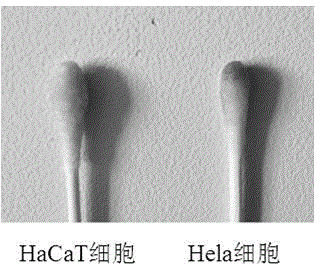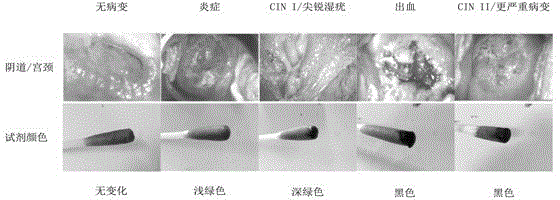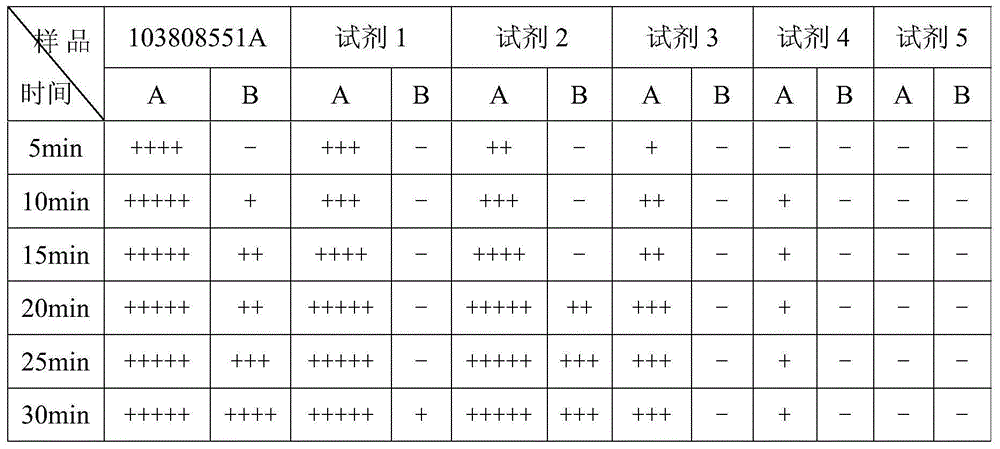Diagnostic reagent for cervical cancer cell detection and preparation method thereof
A diagnostic reagent and technology for cervical cancer, which is applied in biological tests, material inspection products, and material analysis by observing the impact on chemical indicators, etc. problem, to achieve the effect of good stability, good clinical application prospects, and strong reducibility
- Summary
- Abstract
- Description
- Claims
- Application Information
AI Technical Summary
Problems solved by technology
Method used
Image
Examples
Embodiment 1
[0031] Embodiment 1 is used for the preparation of the diagnostic reagent of cervical carcinogenesis cell detection
[0032] The diagnostic reagent used for the detection of cervical cancer cell of the present invention is composed of the following components by mass: 10 parts of glucose, 0.5 part of folic acid, 0.4 part of methylene blue, 0.8 part of lycopene, 0.5 part of 3mol / L sodium hydroxide aqueous solution, dimethyl 90 parts of sulfoxide, 4 parts of acetic acid, 0.01 part of dithiothreitol, and 0.05 part of sodium methyl p-hydroxybenzoate. Its preparation method comprises the following steps:
[0033] (1) Add 10 parts of glucose and 0.8 parts of lycopene into 70 parts of dimethyl sulfoxide, stir and dissolve;
[0034] (2) Prepare 0.5 part of 3mol / L sodium hydroxide aqueous solution, then add 0.5 part of folic acid into the sodium hydroxide aqueous solution, stir and dissolve;
[0035] (3) Add 4 parts of acetic acid into 20 parts of dimethyl sulfoxide, stir and dissolv...
Embodiment 2
[0039] Embodiment 2 is used for the mensuration of the diagnostic reagent stability of cervical canceration cell detection
[0040] Iodine direct titration method: Prepare and accurately draw 3mL of the sample solution to be tested, fully mix it with 3mL indicator starch aqueous solution (10g / L), and immediately titrate with I2 standard solution (0.025mol / L, diluted by 0.1mol / L I2 standard solution) To light yellow, no fading within 30s is the end point, record the volume of I2 standard solution consumed, and calculate the antioxidant capacity of the sample by comparing the volume of I2 standard solution consumed.
[0041]The diagnostic reagent for the detection of cervical cancer cells prepared in Example 1, the reagent sample in the patent "diagnostic reagent for detection of epithelial lesion cells and its preparation process and cotton swab (103808551A)" (100mL of the solution reagent contains methylene blue 0.37 %, fructose 4.69%, glucose 9.38%, vitamin C 1.00%, folic aci...
Embodiment 3
[0042] Embodiment 3 is used for the detection of cell carcinogenesis by the diagnostic reagent used for the detection of cervical cancer cells
[0043] The Hela cell line is derived from the adult cervix. It is a cancer cell line that can proliferate indefinitely. It is a model research cell line for tumor cells in biological and medical research. The HaCaT cell line is an immortalized cell line derived from adult human epidermis that exhibits a normal state of differentiation and provides an ideal model for studying the regulation of human epidermal cells. Although the HaCaT cell line exhibits obvious immortalization, it still does not have the characteristics of tumor cells and can be used as a model of normal cells.
[0044] Tumor cells have a high affinity with methylene blue, and the redox property of methylene blue makes methylene blue have different color-changing reaction spectra in the redox system of tumor cells.
[0045] (1) Good specificity
[0046] Scrape HaCaT ...
PUM
| Property | Measurement | Unit |
|---|---|---|
| Sensitivity | aaaaa | aaaaa |
Abstract
Description
Claims
Application Information
 Login to View More
Login to View More - R&D
- Intellectual Property
- Life Sciences
- Materials
- Tech Scout
- Unparalleled Data Quality
- Higher Quality Content
- 60% Fewer Hallucinations
Browse by: Latest US Patents, China's latest patents, Technical Efficacy Thesaurus, Application Domain, Technology Topic, Popular Technical Reports.
© 2025 PatSnap. All rights reserved.Legal|Privacy policy|Modern Slavery Act Transparency Statement|Sitemap|About US| Contact US: help@patsnap.com



